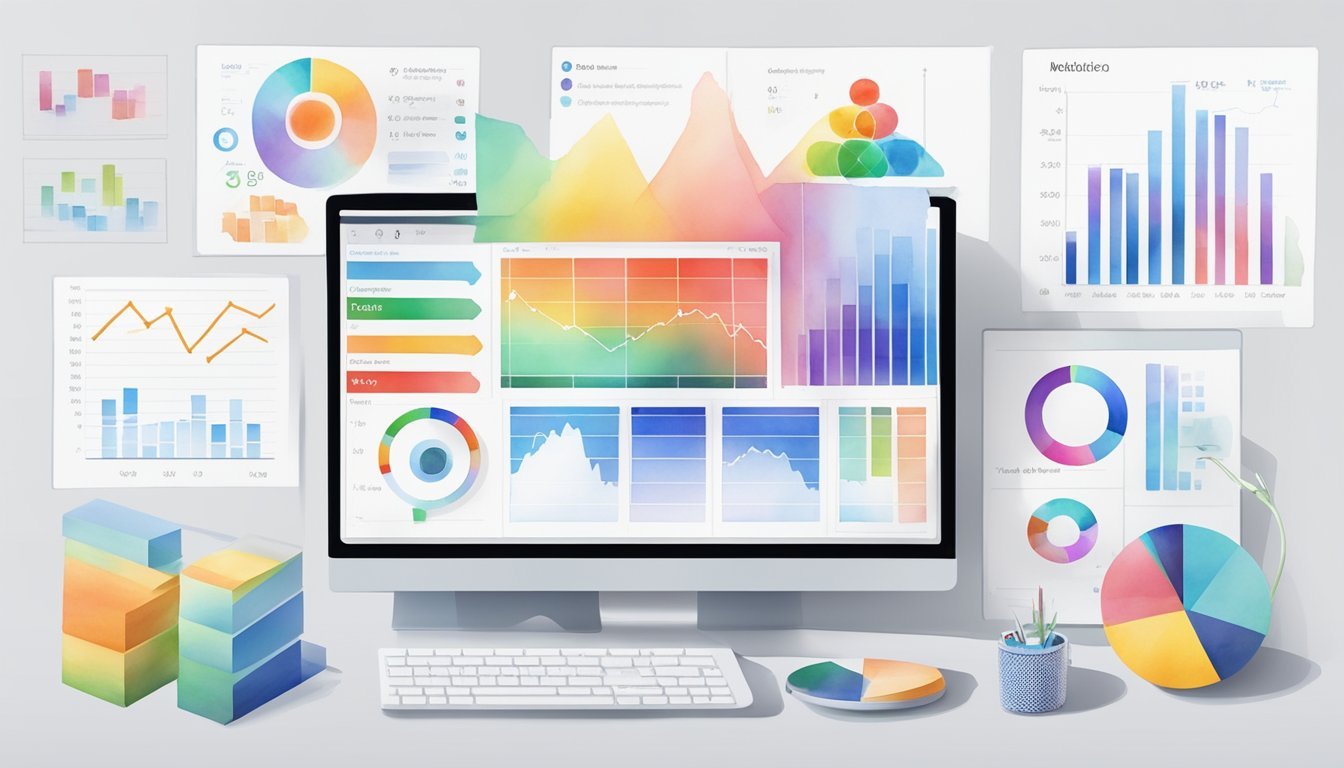9 Analytics Tools Every Digital Marketer Should Master for Optimal Results

In the rapidly changing field of digital marketing, having the right tools can make all the difference.
Mastering analytics tools allows you to measure your campaign’s performance, understand your audience better, and make data-driven decisions. By learning to use these tools effectively, you can elevate your marketing strategies and achieve greater success.

This article will guide you through nine essential analytics tools that every digital marketer should know.
These tools are designed to help you track, analyze, and optimize your marketing efforts across various platforms, ensuring that your campaigns are both efficient and effective.
1) Google Analytics
Google Analytics is crucial for any digital marketer.
It helps you understand visitor behavior on your website.
You can track how users find your site, their actions while on it, and how they exit.
One key feature is the Mobile Performance Report.
This report shows you how your mobile site performs compared to your desktop site.
It provides insight into potential issues mobile users might face.
Another essential aspect is the Audience section.
Here, you can see detailed info about your visitors.
This includes demographics, location, and devices they use.
This info is vital for tailoring your marketing strategies.
Google Analytics also offers custom reports.
You can create specific reports that target your business needs.
Tailoring these reports helps you focus on what’s important to your marketing goals.
The Behavior section shows how users interact with your site content.
You can see which pages are popular and which ones need improvement.
This helps you refine your content strategy effectively.
Integration with Google Ads is another powerful feature.
You can track the performance of your ads and adjust your campaigns as needed.
This ensures you get the most out of your advertising budget.
Real-Time reports let you monitor visitor activity as it happens.
This is useful for seeing immediate effects of changes or promotions.
Knowing how users respond in real-time offers valuable insights.
Having a deep understanding of these reports allows you to make informed decisions.
By using Google Analytics effectively, you can improve your site’s performance and enhance user experience.
2) SEMRush
SEMRush is a powerful analytics tool that many digital marketers rely on.
It provides detailed insights into your website’s performance and your competitors’ strategies.
One key feature of SEMRush is Organic Research.
This tool lets you view your competitors’ organic keyword rankings.
You can estimate their organic traffic, which helps you understand where they excel and how you can compete.
Another valuable feature is the Traffic Analytics.
This tool allows you to analyze the market players’ performance.
It shows you customer demand, interests, and traffic journey, giving you insights to improve your communication and media strategies.
The Ecommerce Keyword Analytics in SEMRush is essential for businesses.
It helps you find lucrative keywords for your eCommerce store, optimizing your product listings and improving visibility in search results.
This feature comes with a seven-day free trial.
SEMRush also offers Analytics Tools and reporting apps.
These tools help you improve workflows, schedule reports, and make data-driven decisions.
They even allow you to manage unlimited clients with customized and branded reports.
The usability of SEMRush makes it a favorite among marketers.
Its dashboard offers an overview of your active campaigns, helping you track and measure results.
This interface is user-friendly and incredibly effective for quick navigation.
For marketers, SEMRush provides essential features that help you monitor and improve your digital marketing strategies.
It’s a tool you should definitely consider mastering for better analytics and competitive advantage.
3) Ahrefs

Ahrefs is a powerful tool for any digital marketer.
It helps you with SEO tasks like keyword research, backlink analysis, and competitor analysis.
You can use Ahrefs to see what keywords your competitors are ranking for.
This information helps you target those keywords and improve your own rankings.
Ahrefs also gives detailed info about backlinks.
You can see who is linking to your site and to your competitors’ sites.
This helps you build a strong link-building strategy.
The Site Audit feature of Ahrefs identifies technical issues on your website.
Fixing these issues can improve your site’s performance and search engine rankings.
Another useful feature is Content Explorer.
It helps you find popular content in your niche.
This can give you ideas for your own content strategy.
Ahrefs provides a Rank Tracker tool.
You can monitor your keyword rankings over time.
This lets you see how your SEO efforts are paying off.
If you’re looking to analyze your competitors’ content strategies, Content Gap is a great feature.
It shows you the keywords for which your competitors are ranking but you aren’t.
The Alerts feature keeps you informed.
You can get notifications about new backlinks, lost backlinks, or mentions of your brand.
Using Ahrefs, you can also explore paid search data.
This includes your competitors’ ad strategies and performance metrics.
Ahrefs is a comprehensive tool that can give you invaluable insights.
For more information, check out their full list of tools.
4) HubSpot
HubSpot is a comprehensive tool for digital marketers.
It offers various features to help you manage your campaigns and analyze your data.
One of HubSpot’s strengths is its user-friendly interface.
Even if you’re new to digital marketing, you can easily navigate its dashboard and tools.
HubSpot provides robust analytics features for tracking your marketing performance.
You can monitor metrics like website traffic, conversion rates, and email campaign success.
This tool also integrates seamlessly with other platforms.
Whether you’re using social media channels or CRM systems, you can connect them all to HubSpot.
Another key feature is the ability to create detailed reports.
These reports can be customized to highlight the data that matters most to you.
HubSpot is not just for analytics; it also offers marketing automation.
You can set up workflows to automate repetitive tasks, saving you time and effort.
Moreover, HubSpot’s blog article highlights how its analytics can be leveraged by marketers.
Overall, HubSpot’s features make it an essential tool for any digital marketing strategy.
5) Adobe Analytics
Adobe Analytics is a must-have tool for digital marketers.
It helps you analyze user behavior and marketing performance.
This tool provides insights to improve your strategies.
You can use Adobe Analytics to track customer interactions across various channels.
It captures detailed data about your visitors.
This allows you to see what works and what doesn’t in your campaigns.
One of the key features is the Data Feed.
This feed provides raw data for deeper analysis.
You can store this data in your own database.
This is useful for building custom reports or integrating with other tools.
Another important tool is the Activity Map.
It shows how users interact with your site through visual overlays.
This lets you see which links get the most clicks, helping you optimize your site layout.
Adobe Analytics also offers dashboard development, making it easy to visualize marketing performance.
You can set up dashboards to track the metrics that matter most to you.
This helps in making quick, informed decisions.
For those who need advanced analysis, Adobe Analytics supports integration and system configurations.
You can customize the tool to fit your needs better.
This includes setting up user roles, data filters, and more.
Using Adobe Analytics, you can increase your conversion rates and improve your marketing ROI.
By understanding your audience’s behavior, you can create more effective campaigns.
This makes it an essential tool for any digital marketer.
6) Mixpanel
Mixpanel is a powerful tool designed for tracking and analyzing user interactions with your products and services.
It provides in-depth insights into user behavior, which you can use to improve your marketing strategies.
One of Mixpanel’s strengths is its ability to support robust marketing analytics.
You can gather insights across various acquisition channels, ensuring you understand the full user journey from start to finish.
Mixpanel makes it easy to set up and start tracking data.
You can switch to Mixpanel using a Google Tag Manager template, which simplifies the setup process and starts auto-tracking page views almost immediately.
The platform excels in collaboration between marketing and product teams.
This collaboration can lead to a more cohesive strategy, aligning marketing efforts with product development based on actual user data.
Mixpanel provides a ready-to-use marketing analytics template to get you started quickly.
This template helps you measure the impact of your marketing campaigns more effectively.
Data integration is another key feature.
Mixpanel can integrate with other platforms, offering more comprehensive data analysis.
This integration is crucial for a holistic view of your marketing efforts and their outcomes.
For anyone looking for a reliable marketing analytics tool, Mixpanel stands out for its user-friendly features and robust analytics capabilities.
To learn more, you can visit Mixpanel Marketing Analytics.
7) Kissmetrics
Kissmetrics is a powerful tool for tracking user behavior on your website.
It allows you to see how visitors interact with your site and where they drop off.
This insight helps you optimize your website for better engagement and conversion.
One of the main advantages of Kissmetrics is its ability to integrate with other platforms.
You can connect it with email marketing tools, A/B testing software, and e-commerce systems.
This helps you get a detailed understanding of your marketing efforts.
Kissmetrics offers robust analytics that lets you track individual users over time.
This means you can see how users are progressing through your sales funnel.
You can identify stumbling blocks and improve the user experience.
In comparison to Google Analytics, Kissmetrics focuses more on individual user data.
While Google Analytics provides a broad overview, Kissmetrics digs deeper into user-specific actions.
This can be especially useful for businesses aiming to boost customer retention.
Marketers also appreciate Kissmetrics for its detailed reporting features.
These reports allow you to tailor your marketing strategies based on real data.
You can create custom reports that match your specific needs.
By using Kissmetrics, you gain valuable insights that can lead to better decision-making.
Whether you’re tracking user engagement or measuring the success of a campaign, Kissmetrics provides the tools you need.
It’s a worthwhile addition to any digital marketer’s toolkit.
8) Hotjar

Hotjar is an essential tool for digital marketers.
It allows you to understand user behavior on your website through various features.
You can track user actions such as clicks, taps, and mouse movements.
This helps you see how users interact with your site.
Hotjar provides heatmaps, which show where users spend the most time on a page.
This visual data can highlight popular sections and areas needing improvement.
Another useful feature is user recordings.
You can watch real users navigate your site.
This can reveal usability issues and help improve user experience.
Hotjar also offers feedback tools.
You can create surveys and polls to gather direct input from your audience.
This helps you understand user needs and preferences.
Integrating Hotjar with Google Analytics can give you even deeper insights.
You can combine quantitative and qualitative data for a comprehensive analysis.
You don’t need to worry about sharing insights manually.
Hotjar allows you to save and share highlights easily.
This streamlines collaboration within your team.
For more information on using Hotjar for data analytics, you can visit this guide.
To learn about combining Hotjar with Google Analytics, check out this resource.
9) Crazy Egg
Crazy Egg is a visual web analytics tool that helps you understand how visitors interact with your website.
It offers various features to analyze user behavior and improve your site’s performance.
One of the standout features of Crazy Egg is its heat maps.
These heat maps are visual representations of where users click, scroll, and hover on your site.
Crazy Egg also provides scroll maps.
Scroll maps show you how far down the page your visitors are scrolling.
This data helps you determine if your content is engaging enough to keep users scrolling and interacting.
Another helpful tool is the Confetti feature.
It breaks down clicks by referral sources, search terms, and other criteria.
This allows you to see which sources bring in the most engaged users.
The Overlay tool helps you see the number of clicks on each element on your site.
This can be useful for refining your design and improving user experience.
Crazy Egg integrates easily with other tools like Google Analytics.
This can provide a broader view of your site’s performance and user behaviors.
For businesses focused on enhancing user engagement and conversion rates, Crazy Egg is highly effective.
It offers a free 30-day trial to test its features.
With insights from Crazy Egg, marketers can make informed design decisions.
It’s a valuable tool for anyone serious about optimizing their website’s user experience.
Understanding Analytics Tools
Analytics tools are essential for understanding your audience, tracking your marketing efforts, and making data-driven decisions.
Importance of Analytics in Digital Marketing
Analytics tools help you track the effectiveness of your campaigns.
They provide insights into customer behavior, reveal trends, and identify what’s working and what isn’t.
By analyzing data, you can improve your strategies and increase your return on investment (ROI).
These insights allow you to allocate your budget more effectively, targeting the channels and demographics that deliver the best results.
Types of Analytics Tools
There are various types of analytics tools, each serving a different purpose:
-
Web Analytics: Tools like Google Search Console help monitor your website’s performance.
-
Social Media Analytics: Tools like BuzzSumo track engagement and reach.
-
Dashboard Tools: Tools like Klipfolio turn raw data into visual insights.
-
Content Analytics: Determine which types of content perform best to refine your content strategy.
Use the right mix of these tools to gain a comprehensive view of your marketing efforts.
Advanced Data Analysis Techniques

In digital marketing, advanced data analysis techniques like segmentation and behavioral analysis can help you optimize campaigns and enhance customer satisfaction.
Segmentation and Targeting
Segmentation involves dividing your audience into smaller groups based on specific criteria such as demographics, interests, or behavior.
This allows you to tailor your marketing efforts to each segment, improving engagement and conversion rates.
To begin with segmentation, you can use tools like Google Analytics to gather data about your visitors’ age, location, gender, and interests.
By analyzing this data, you can create targeted campaigns for each segment, ensuring that your message resonates with your audience.
Moreover, segmentation helps you identify high-value customers and allocate resources towards acquiring similar profiles.
You can also track the performance of each segment to continuously refine your strategies.
This way, your marketing efforts become more efficient and effective.
Behavioral Analysis
Behavioral analysis involves studying the actions of your users to understand their preferences and predict future behaviors.
This technique helps you create personalized experiences by examining patterns such as browsing history, purchase behavior, and engagement with content.
To implement behavioral analysis, utilize Python, a versatile programming language known for handling large datasets and complex calculations.
You can also leverage machine learning algorithms to identify trends and make recommendations.
Additionally, behavioral analysis enables you to optimize your website’s user experience.
For instance, by analyzing click-through rates and session durations, you can identify areas for improvement and test different layouts or content strategies.
Understanding user behavior helps you to refine your approach and deliver more relevant content, ultimately boosting satisfaction and retention.

